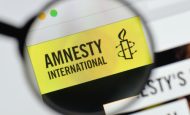Amnesty International’s Antisemitic Campaign against Jewish Tourism
On January 30, 2019, Amnesty International published “The Tourism Industry and Israeli Settlements,” a report alleging that “the Israeli government has political and ideological reasons for developing a tourism industry in occupied East Jerusalem and Area C of the West Bank.” According to Amnesty, “Israel has constructed many of its settlements close to archaeological sites … [as] part of an active campaign to normalize and legitimize Israel’s increasing control of the OPT.”
In this publication and the broader campaign, which is also designed to bolster the expected UN BDS blacklist, Amnesty denies Jewish connections to historical sites – including in the Old City of Jerusalem – and in essence faults Israel for preserving Jewish historical and cultural heritage, as well as places that are holy to Christians.
Denying Jewish Historical Connection to Holy Sites
Amnesty repeatedly diminishes Jewish connections to holy sites in the Old City of Jerusalem and in other areas of religious and historical importance to Jews. Amnesty accuses Israel of creating a “settlement tourism industry” to help “sustain and expand” communities beyond the 1949 Armistice line. Israel’s interest in Jewish archaeology is “to make the link between the modern State of Israel and its Jewish history explicit,” while “rewriting of history [which] has the effect of minimizing the Palestinian people’s own historic links to the region.”
In Amnesty’s antisemitic narrative, the Israeli government and others “use [] archaeology and tourism as cover for removing the Palestinian residents of Silwan and installing settlers,” and “the settlers in Hebron see tourism as one way of strengthening their position. For political and financial reasons, they want as many people as possible to visit them.” Similarly, online tourism websites that list such sites are portrayed as complicit in these same motives.
The possibility that Jews would visit holy sites and want to see archaeological remnants of biblical locations for their religious and historical significance is not entertained.
Erasing Christian Holy Sites in Jerusalem
Amnesty notes that “The top three most visited places by foreign tourists in 2017 were all in Jerusalem’s Old City,” suggesting that this is a serious problem that needs to be solved. Only in a footnote do we learn that these are “the Western Wall, the Jewish Quarter and the Church of the Holy Sepulchre.” (See above for a discussion of the Jewish sites.)
Amnesty also complains that the “financial benefits both to Israel and to businesses operating in occupied territory …is because most foreign visitors also enter the OPT.”
By suggesting that foreign tourism to Israel is about supporting settlements, not about religious and/or historical interest, Amnesty International erases the Christian connection to the Holy Land.
Ideology Instead of Research Methodology
As with most Amnesty publications, there is no meaningful research methodology, and the resulting analysis reflects this. Throughout, Amnesty makes claims based on unverifiable testimonies, provides statistics out of context, and attacks tourism companies for alleged violations without any systematic analysis of their activities. There is almost no original research, with most factual claims sourced to NGO and UN publications (see below).
An illustrative example of Amnesty’s misleading factual claims concerns the Dead Sea. Amnesty quotes statistics from the Israeli government that “45% of foreign visitors went to the Dead Sea, much of which is in the OPT.” While the northern parts of the Dead Sea abut the West Bank, the primary tourist attractions (such as the Ein Gedi nature reserve, Masada, and the resorts in Ein Bokek) are located within Israel’s pre-1967 borders. Amnesty’s inclusion of ultimately irrelevant information reflects its tendentious goals and lack of basic knowledge of the topic area.
Amnesty also relies on anonymous and unverified interviews. For instance, in discussing the threat of home demolitions in Silwan, Amnesty states that “In this resident’s opinion, the Israeli government was using the fines as a way of forcing people to vacate al-Bustan. ‘They are trying to make us leave’” (emphasis added). Amnesty also relies on an unconfirmed interview with a family to claim that as soldiers arrested their son, “they threw stun grenades to disperse family members who were peacefully following them” (emphasis added).
Amnesty further accuses companies such as Airbnb, TripAdvisor, Expedia.com, Hotels.com, and Booking.com of contributing to “human rights violations” without systematically reviewing the activities of these companies. Instead, Amnesty selectively and on an ad-hoc basis points to a tourist destination review or a rental property listing as grounds for accusing the company of being somehow complicit in a host of human rights violations. The long list of human rights concerns are unrelated to the companies and tourism industries mentioned in the report, such as “violations of” the “right to life,” “freedom of expression,” “rights of the child,” and “right to education.” Indeed, it is unclear how a Jewish individual visiting the Western Wall in the Jewish Quarter of the Old City of Jerusalem would somehow be guilty of such violations, or how a tourism website advertising this would also somehow be complicit.
Reliance on Politicized and BDS NGOs
Not surprisingly, Amnesty International relies on a number of pro-BDS organizations and other political NGOs to support its arguments against Jews preserving and visiting Jewish historical sites in the West Bank. These organizations include the Popular Front for the Liberation of Palestine (PFLP) terror-tied NGOs Defense for Children International – Palestine (DCI-P) and Al-Haq; the pro-BDS NGOs Who Profits, EAPPI, Human Rights Watch, and Diakonia; and Israeli political advocacy NGOs B’Tselem, Emek Shaveh, Kerem Navot, Ir Amim, and Yesh Din.
Amnesty also relies on documents published by various UN agencies known for their hostility to Israel, including UNOCHA, OHCHR, and the Human Rights Council. These agencies and their reports regularly cite the same NGOs relied on by Amnesty in its report, further reinforcing the bias.


